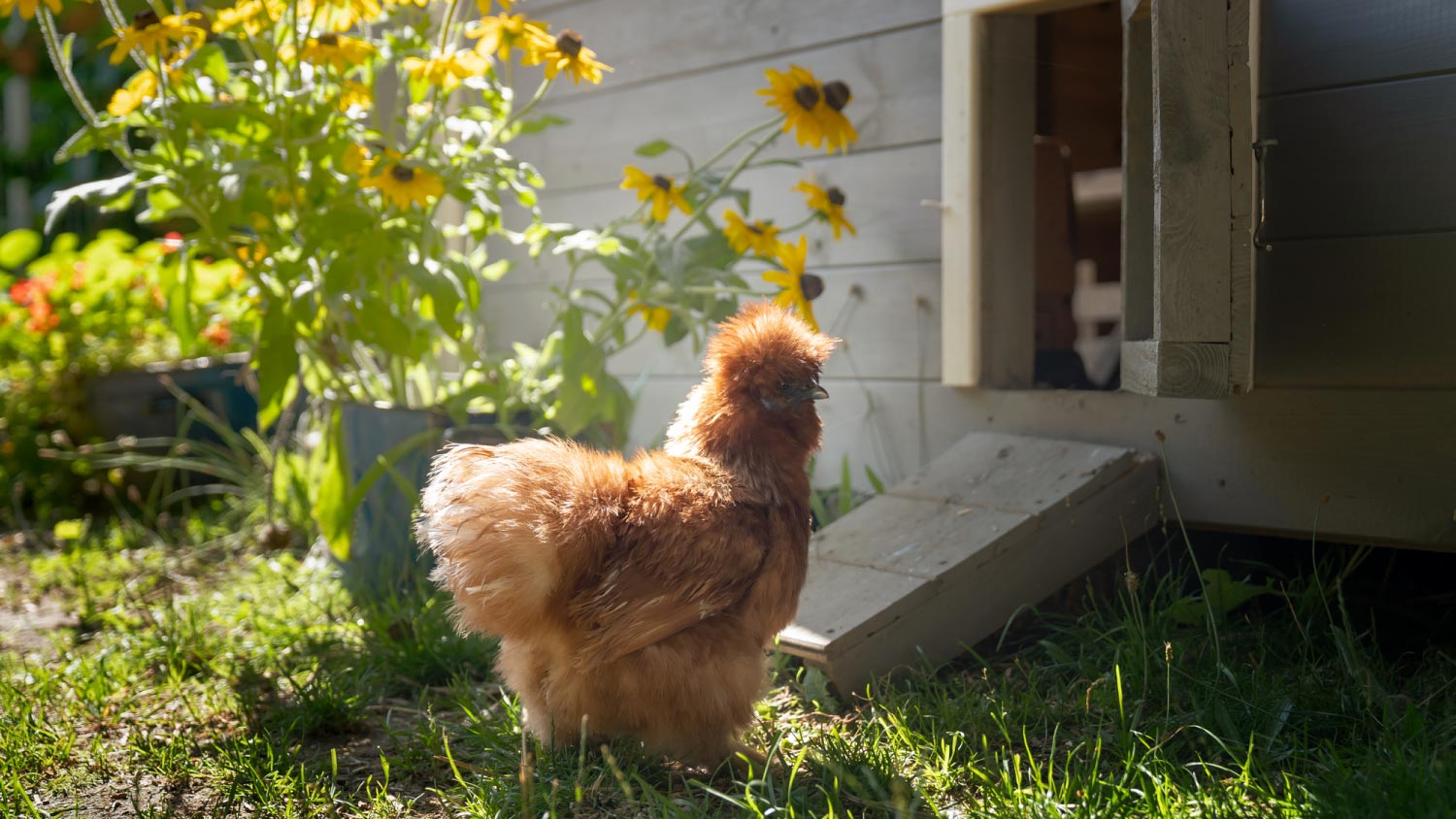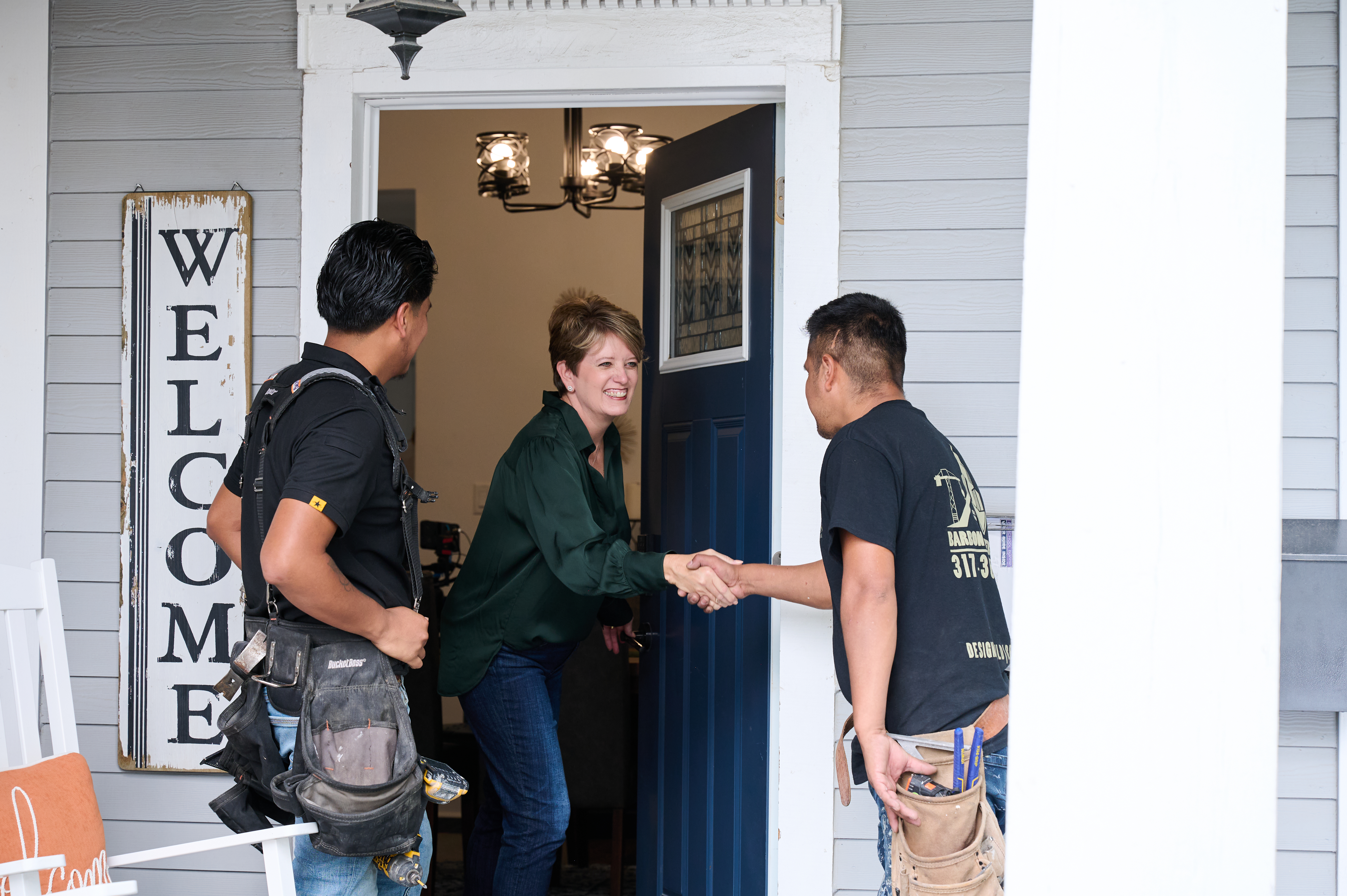
Looking to add a personal touch or some patriotic flair to your property? Learn about flagpole installation costs and how to budget appropriately.
Handyman service costs depend on your project and location. Check with a local pro for your specific job.
A chicken coop for a small flock costs about $300, but if you have a dozen chickens or more, you’ll pay between $500 and $2,000.
An easy-to-move chicken tractor will cost around $400, while a stationary walk-in chicken coop will cost $650 or more.
The materials you choose for the floor, walls, and roof will significantly impact the overall cost of the project.
Nesting boxes cost about $30 each, and you’ll need one nesting box for every three to five hens.
Whether you want to build a chicken coop for the farm-fresh eggs or to watch the chickens peck away the day, it’s important to know what kind of budget is required. On average, a chicken coop costs $650. Small options start at just $100, whereas a large, palatial setup with all the bells and whistles could run $4,000 or more. Let’s examine all the cost factors, including style, material, labor, and floor type.
Prefabricated chicken coop kits include all the materials you'll need and they’re usually more affordable than custom options. Their design is straightforward, and they take less time to assemble, which makes them perfect for beginners. However, they lack flexibility in layout possibilities and may not be as durable or predator-resistant as custom coops.
When it comes to size, design, and materials, the sky's the limit for a custom coop. You can tailor it to the size of your yard and your flock's specific needs. A custom coop often incorporates additional features not found in a kit, like greater insulation and built-in storage. While custom coops can provide more protection for your chickens, they require more time, effort, and a larger budget.
The cost of a custom coop varies based on several key factors, so consider the size, materials, design, type, and additional features when budgeting for this project.
The size of a coop is one of the most significant factors, with bigger coops required for larger flocks. If you only need a small coop for a few chickens, your cost will be around $300, while a large coop for a dozen or more chickens will cost $500 to $2,000, depending on the size.
The materials you use to build your coop will impact its cost. For example, using more affordable wall options, like plywood and reclaimed wood, will be cheaper than more durable choices like metal or concrete. Keep in mind that longer-lasting materials are worth the investment to keep your chickens safe for many years.
Simpler coops designs are more budget-friendly, while multi-level or decorative coops can increase costs. Consult a local handyperson to determine a coop design that suits your chicken’s needs, yard size and layout, and budget.
If you purchase a chicken coop kit, you can hire a local handyperson. Handypeople charge $50 to $150 per hour and can likely put together a moderately-sized coop in a few hours.
For a custom build, you should hire a carpenter. A carpenter costs up to $100 per hour, but they will likely charge by the project. A local carpenter may take half a day to build a modest coop suitable for six small chickens. For something more substantial, such as an all-in-one walk-in coop suitable for a flock of 24 or more hens, the project could take up to five days, with labor costs up to $1,000.
Optional accessories, such as automatic feeders, lighting, or heating systems, will raise the budget, as will nesting boxes, roosting bars, ventilation, insulation, and predator-proofing materials.

Take a look at the most common styles and their associated costs for materials only.
| Chicken Coop Style | Cost Range | Average Cost |
|---|---|---|
| A-Frame | $200–$300 | $250 |
| Tractor | $300–$500 | $400 |
| Walk-In | $300–$1,000 | $650 |
| All-in-One | $1,000–$3,000 | $2,000 |
A-frame chicken coops cost around $250 for small units that accommodate up to four medium-sized chickens. These coops usually feature a simple design with a nest box and a run, but they are best suited for temporary housing due to their limited space. While they are budget-friendly and easy to construct for those with basic DIY skills, they can be challenging to clean and don't provide much room for the chickens to roam. To keep their hens happy, many chicken owners allow their birds to free-range in the backyard during the day and then tuck them in at dusk.
Chicken tractors cost around $400 for a small, DIY model and are primarily used for temporary housing or overnight shelter for birds that free-range during the day. These tractors feature a coop on top and a mesh-enclosed run below, and their wheels allow you to easily move them around your yard. This mobility enables you to address specific problems, such as pest control or weed management, by relocating the tractor to let the hens do their work. Additionally, chicken tractors are compact and can serve as temporary quarantine homes for sick birds or for integrating new members into your flock.
Walk-in chicken coops cost around $650 and provide ample space for a dozen medium hens or eight to ten larger breeds. While larger coops offer more room for bigger flocks, they do not come with an attached run, so you'll need to allow your birds to free-range or build a suitable run. These coops are easy to clean due to their spacious design, allowing for better access and providing more room for nesting boxes and enrichment activities. You can purchase these coops as kits, opt for a custom build, or save money by converting an existing garden shed.
All-in-one chicken coops cost an average of $2,000, but they can go up to $4,000 or more, depending on the size and structure. If you want a large, self-sustaining meat and egg flock that lives in a custom chicken castle, expect to pay a carpenter well over $4,000.
The all-in-one design includes a substantial walk-in coop with a large run attached. While they're big enough to house large breeds, unless the run is huge, it's still advisable to let your chickens roam if possible or, if not, to limit the size of your flock to keep them happy and healthy.
The materials you choose for your coop impact the total price. You'll need to choose framing, wall and roof covering, and mesh.
| Type of Material | Cost Range | Average Cost |
|---|---|---|
| Softwood | $2–$3 per board foot | $2.50 per board foot |
| PVC | $5–$6 per linear foot | $5.50 per linear foot |
| Pressure-Treated Lumber | $7–$10 per board foot | $8.50 per board foot |
| Redwood | $10–$12 per board foot | $11 per board foot |
| Plywood | $10–$20 per sheet | $15 per sheet |
| Corrugated Tin | $15–$20 per sheet | $17.50 per sheet |
| Plastic | $25–$30 per sheet | $27.50 per sheet |
| Mesh | $30–$40 per board roll | $35 per board roll |
The right material can guard against predator and pest incursion, make cleaning easier, insulate the coop in cold weather, and be comfortable on your chicken's feet.
| Coop Floor Material | Cost Range | Average Cost |
|---|---|---|
| Vinyl | $2–$8 per square foot | $5 per square foot |
| Wooden Board | $7–$9 per board foot | $8 per board foot |
| Rubberized Roofing Material | $7–$9 per square foot | $8 per square foot |
| Plywood | $10–$20 per sheet | $15 per sheet |
| Wire | $35–$45 per roll | $40 per roll |
| Rubber Mats | $45–$80 per sheet | $62.50 per sheet |
| Concrete | $75–$125 per cubic yard | $100 per cubic yard |
There are many variables that impact the cost of building your chicken coop, as well as ongoing costs you need to account for.
Transforming an existing structure instead of building a kit or building from scratch can significantly reduce the cost of your coop, as you've already got most of the timber, the roofing material, and the structure itself in place. So you'll only need to spend a little on wood for roosts, nest boxes, mesh, and your choice of flooring.
If you live in areas with harsh winters, you'll need to invest more in winterizing your coop compared to chicken keepers in warmer climates. Adding insulation to the walls and roof is essential, ensuring it's covered with plywood or a similar material that your hens can't peck through. Additionally, insulating the egg boxes will help maintain egg production during the winter months, and a thick layer of sand on the floor of the run can protect your hens' feet from frostbite. To prevent boredom, which can lead to aggressive behavior, provide entertainment options, such as hanging a cabbage on a string or introducing safe novelty items to keep them happy and stimulated.
Some chicken illnesses are contagious, as are parasites like chicken mites. In that scenario, you’ll need to build a separate quarantine coop. Not just for ill or infested chickens, but also for when you want to introduce new birds to your flock. A basic A-frame quarantine coop can cost as little as $200.
If you live in an area with hard winters and struggle to keep your coop warm, get a temperature controller. Temperature control systems include a coop heater that turns on when the temperature dips too low and turns off automatically when the temperature rises sufficiently. These cost between $50 and $200, depending on the size of your coop.
Nesting boxes cost around $30 each. Not all kits come with enough egg boxes and, if you're converting a shed or building a coop from scratch, you'll need to install nest boxes anyway.
Ideally, you need at least one nest box for every hen. Plus, if you have a self-sustaining flock, you'll need to provide roomy nest boxes for your hens to hatch their eggs.
Roosting areas are where chickens go to sleep and rest. They typically include an elevated bar where the chickens can perch themselves. Because chickens poop while they sleep, the elevation allows the droppings to land on the floor below rather than dirtying their feathers. This won’t add much to your overall costs, as you only need one 2x4 wood plank per chicken to build an ideal roost.
Chickens don’t just like to roll around in the dirt for no reason. Doing so removes debris and germs from their feathers and reduces their risk of contracting parasites and illnesses. Building one yourself takes just minutes and doesn’t require any additional expenses—unless you choose to invest in diatomaceous earth, which has more protective qualities than other types of dirt.
Ducks need much more space for a number of reasons—including that they roost on the floor and need more drinking and bathing water—so their coops are typically more pricey as a result. The cost of materials for a duck coop starts at $140 and can go up to more than $4,000, whereas most chicken coops will max out at that amount. From there, building and labor can add anywhere from $100 to $2,000 more to your final bill.
If you hire a local handyperson for chicken coop maintenance, expect to pay around $60 per hour. Common issues are predators causing damage as they attempt to bite through the mesh or burrow up through the floor, hens pecking through floor, wear and tear on the exterior, or toxic paint.
You'll also need to clean the coop regularly and treat for lice, mite, and other parasite prevention. Treating to prevent parasites is as easy as adding diatomaceous earth to your chicken's dust bath every month, and sprinkling DE inside the coop. Food-grade DE costs less than $20 for a 1-gallon bucket.
Depending on the coop you want to build, taking the DIY route can save you upwards of $1,000 on labor costs. All you need to pay for is the materials and any tools you don't already have.
Building a simple chicken coop is fairly easy if you've got a saw, a hammer, and some basic DIY skills. Yes, you'll need to give some thought to the location of your coop, how big it needs to be (each bird needs a bare minimum of 3-square-feet of indoor space), and how you can best protect it against would-be predators. But the actual build is pretty straight forward.
As mentioned, you could save on labor fees if you DIY build a chicken coop because you’d only need to pay for materials and tools. Depending on how big and elaborate of an enclosure you want, you’ll pay anywhere from $100 to $2,000 to build a chicken coop yourself. That lower range assumes you’re building a small coop, and you already own the tools. On the higher end of the price range, you’d be paying for a larger coop with more premium materials and special features.
You can save money on this pet project by using a coop kit, which is a less expensive option, but if you're building a custom coop, consider building it yourself. Free and low-cost plans are available online, and you can purchase tools and materials as needed.
Use repurposed materials or use discounted supplies whenever possible. A simple design will reduce the cost while providing a functional space for your chickens. Used coops and coop kits are often resold online, or you can convert a free-standing structure (like a shed) into a suitable coop.
Home is the most important place on earth, which is why Angi has helped more than 150 million homeowners transform their houses into homes they adore. To help homeowners with their next project, Angi provides readers with the most accurate cost data and upholds strict editorial standards. We extensively research project costs to develop the pricing data you see, so you can make the best decisions for you and your home. We rely on reputable sources, including the U.S. Bureau of Labor Statistics, academic journals, market studies, and interviews with industry experts—all to ensure our prices reflect real-world projects.
Want to help us improve our cost data? Send us a recent project quote to [email protected]. Quotes and personal information will not be shared publicly.
From average costs to expert advice, get all the answers you need to get your job done.

Looking to add a personal touch or some patriotic flair to your property? Learn about flagpole installation costs and how to budget appropriately.

Learn how much it costs to board up a window to buy yourself some time and maintain home security while you wait for the permanent repair.

Discover wheelchair ramp cost estimates, including installation, materials, and tips to save. Learn what impacts your price and how to budget for your project.

If you’re not keen on spending your afternoon assembling flat-pack furniture, bring in the professionals. How much does furniture assembly cost? It can be shockingly affordable.

Selecting the best anchors for brick is essential for hanging decor successfully. Learn about the types of anchors to determine what you need for your project.

Both a handyman and contractor serve different purposes for your home projects. This guide will help you hire the right professional for your unique job.